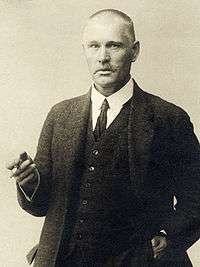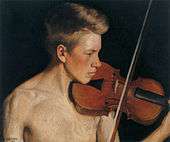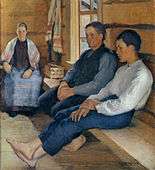Pekka Halonen

Pekka Halonen (23 September 1865 – 1 December 1933) was a painter of Finnish landscapes and people in the national romantic style. His favorite subjects were the Finnish landscape and its people which he depicted in his Realist style.[1]
Biography
Pekka Halonen was born on 23 September 1865 in Linnasalmi, Lapinlahti, Finland, the son of Olli Halonen, a farmer, and Wilhelmina Halonen (née Uotinen). Halonen's father was himself an amateur artist who not only ran the farm, but also worked as a decorative painter on commissions from churches in neighbouring districts. Halonen often accompanied his father on these painting trips and was thus introduced into the craft of painting.
He studied in Helsinki at the Art Society's Drawing School for four years. He graduated with good grades and won a scholarship to study abroad. He went in 1890 to Paris, where he first studied at the Academie Julian[2] and later under Paul Gauguin.[3]

In 1895 Pekka Halonen married a young music student, Maija Mäkinen. In the beginning of their marriage, the couple lived in several places before settling down in a house with a studio on Lake Tuusula in Tuusula, Finland in 1895. Here the Halonen family lived in an imposing pinewood villa known as ‘Halosenniemi’. Halosenniemi was designed by Pekka Halonen himself and his brother Antti Halonen and was completed in 1902.
The building is now a museum that includes original furnishings and Halonen’s own art. On the shores of the lake where he resided an artists’ community flourished, helping to develop a sense of Finnish national identity. Halosenniemi was designed with the two-storey studios of Paris in mind, with high ceilings and tall windows in the studio, and second-floor living-quarters accessible by a set of stairs and a balcony that overlooked the studio.
Adjacent to the house Halonen built a sauna, which in typical Finnish tradition also served as a laundry. The landscape near Halosenniemi was an important source of inspiration for his art.[4] In Tuusula Halonen had a wide circle of artist friends and relatives which provided him with a daily source of social and cultural stimulation.
Hallonen and his wife had eight children, four sons and four daughters. Halonen died in Tuusula on 1 December 1933.[3]
Work
Halonen chronicled the Finnish landscape and its people. He had an early interest in Symbolism, but Gauguin’s decorative Synthetism, as well as Japanese woodcuts, had a deeper impression on his work.[1]
Many of his paintings depict simple scenes from his everyday surroundings, such as Sauna in the Snow (1908), which vividly captures the stillness and subtle fragrance of freshly fallen snow. When at the beginning of the 20th century Finland’s existence was threatened, Halonen strove to foster a sense of national pride through symbolic interpretations of the Finnish landscape.[1]
Halonen stated that he never painted for anyone but himself. He felt that “Art should not jar the nerves like sandpaper – it should produce a feeling of peace.”[3]
Selected works
- Pekka Halonen
 Washing on the Ice, 1900
Washing on the Ice, 1900 The Violinist, 1900
The Violinist, 1900.jpg) Autumn Landscape, 1914
Autumn Landscape, 1914 Mowers men, 1891
Mowers men, 1891 Holiday in the new house, 1894
Holiday in the new house, 1894 In the Sauna, 1925
In the Sauna, 1925
References
- 1 2 3 Aimo Reitala. "Halonen, Pekka." Grove Art Online. Oxford Art Online. Oxford University Press. Web. 2 Mar. 2016
- ↑ Grove Art Online
- 1 2 3 Pekka Halonen (1865–1933) at the Halosenniemi Museum
- ↑ Halosenniemi at the Halosenniemi Museum
External links
![]() Media related to Pekka Halonen at Wikimedia Commons
Media related to Pekka Halonen at Wikimedia Commons